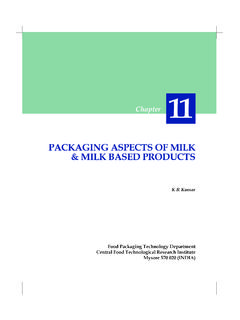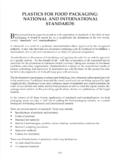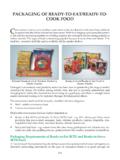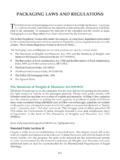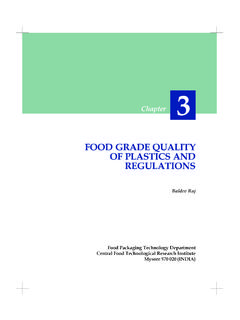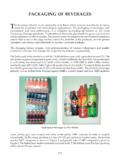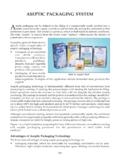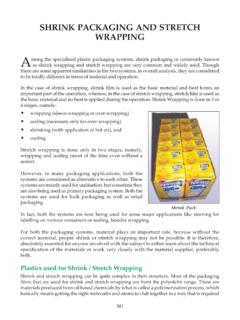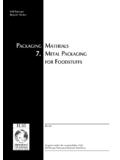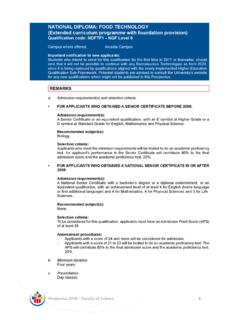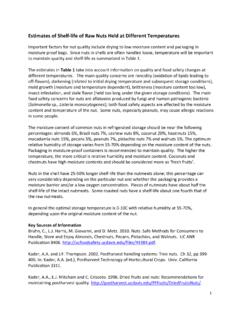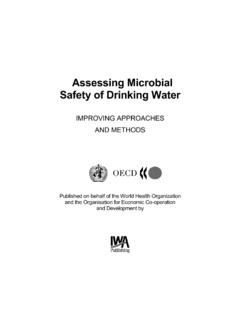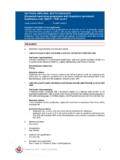Transcription of PACKAGING OF BAKERY PRODUCTS - ICPE
1 71 PACKAGING OF BAKERY PRODUCTSThe BAKERY industry, production of which has been increasing steadily in the country, is thelargest among the processed food industries in India. The two major BAKERY industries,viz. bread and biscuit account for about 82% of the total BAKERY annual production ofbakery PRODUCTS , whichincludes bread, biscuits,pastries, cakes, buns, rusk etc.,is estimated to be in excess of 3million tonnes. The productionof bread and biscuits in thecountry, both in the organisedand unorganised sectors, isestimated to be around tonnes and 11 milliontonnes respectively.
2 The cakeand pastry market estimated million tonnes, is the fastgrowing market with volumegrowth of 16%. The break up ofRange of BAKERY Productsproduction of bread and biscuits is given in Table 1 Production of BAKERY PRODUCTS ( 000 tonnes) 200017001700 India s BAKERY market at Rs. billion tonnes makes it the third largest market in Asia Pacific,only after Japan and BAKERY industry in India comprises of organised and unorganised sectors. The organisedsector consists of large, medium and small-scale manufacturers who produce packagedbiscuits and bread.
3 The unorganised sector consists of small BAKERY units, cottage andhousehold type manufacturing their goods without much PACKAGING and distributing theirgoods in the surrounding areas. Bread market is estimated to be growing at around 7% volume terms, whereas the biscuit market has witnessed a higher growth at around 8-10%. Within the biscuit category, cream and speciality biscuits are growing at a faster rate of20% The per-capita consumption of biscuits in India is around 900 gms as compared to15-20 kg. for developed countries.
4 The consumption of biscuits is equally divided betweenthe urban and rural population. Demand for biscuits in 2003-2004 is likely to exceed PRODUCTS are an important source of nutrients viz. energy, protein, iron, calcium andseveral vitamins. Commercial bread and biscuits contain around to proteinrespectively. Biscuits are amongst the lowest cost processed food in the country when comparedto other Indian sweets and salted snacks. Biscuits are easy to use during travel or at homebecause of its availability in variety of pack sizes.
5 They also offer substantial energy. Thusbiscuits have an important role to play as a diet supplement for both adults and children. It isno longer viewed as a luxury tea-time snack but essential daily food component for an averageIndian PACKAGING of BAKERY PRODUCTS is closely interlinked with production, preservation,storage, transportation and marketing. The importance of PACKAGING can further be gaugedfrom the fact that PACKAGING constitutes a fair portion (10 to 25%) of the entire cost of RangeBakery PRODUCTS contain high nutritive value and are manufactured from wheat-flour, sugar,baking powder, condensed milk, ghee (fat), salt, jelly, dry fruits, various essences and flavouringetc.
6 Different type of BAKERY PRODUCTS can be classified as:Dry BAKERY PRODUCTS Biscuits: Soft biscuits, hard biscuits, cookies, crackers, fancy biscuits, cream BAKERY PRODUCTS Bread: Sweet bread, Milk bread, Masala bread, Garlic bread, Fruit bread etc. Buns: Fruit buns, hamburger buns, dinner rolls, crisp bread, pizza. Others: Cakes, pastries, doughnuts, muffins CharacteristicsDry BAKERY ProductsThese PRODUCTS are fragile and characterised by a low moisture content (<6%) low water activity(Aw = ) and are highly hygroscopic.
7 Moisture is the decisive criteria for the organoleptic73properties and acceptability by the consumers. The basic characteristics of dry BAKERY productsare given in Table 2 Basic Characteristics for Dry BAKERY ProductsPropertiesBasic Characteristics of ProductsGeneralFoodstuffs for long storagePhysical-mechanicalFragileLightLo w resistance to moistureVariable sizesOrganolepticCrisp or crunchy textureDistinctive flavoursFlavors that may change (loss of initial flavour or ingress offoreign flavour)Flavour that may deteriorate (go stale, soapy or bitter, etc.)
8 Physico-chemicalLow moisture contentHygroscopicContaining fatty matterGreasy surfaceSensitive to: Oxidation Enzymatic reactions Non-enzymatic browning LightTechnical economicalIndustrialLow sales price Loss of Crispness: Biscuits have a low moisture content, high fat level and are fragile innature. Hence, they have to be protected from these three aspects. Since the biscuits consistsof wheat flour, fat and shortening, sugar, salt and flavouring agents they are pre-dominantlysensitive to water vapour interchanges (moisture) and oxygen reactions.
9 They generallyhave an initial moisture content of 2-3% equilibrating to 10-15% RH. The critical moisturelevel from the point of loss of crispness varies between 4 to 6%. The shelf-life of biscuitsdepends upon: Inherent characteristics of the product Barrier and other functional properties of the PACKAGING material74 PACKAGING operations adopted Distribution and storage patterns followed Economic considerationsThere is a well-established relationship between water vapour sorptions and chemical, physicaland stability characteristics of biscuits.
10 For predicting product shelf-life and packageperformance with respect to water vapour transfer, the data required is: Water sorption isotherm Water Vapour Transmission Rate (WVTR) of the PACKAGING material Storage ConditionsSince these are moisture sensitive PRODUCTS , water vapour transmission rate of the packagingmaterial used is of importance as it is closely associated with drying, physical structure andprotective action against oxidation. These PRODUCTS not only become brittle and hard but alsodevelop oxidative rancidity at very low moisture contents.
